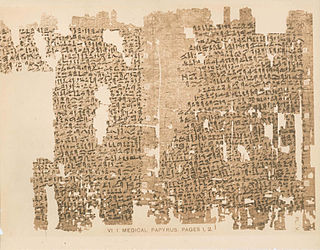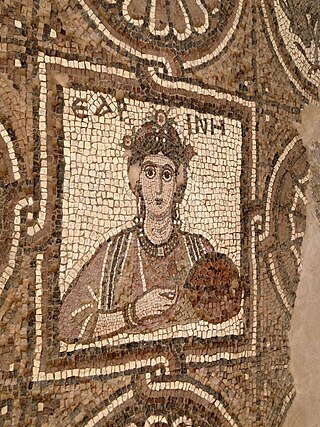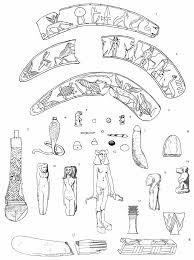The Ramesseum medical papyri constitute a collection of ancient Egyptian medical documents dating back to the early 18th century BC, found in the temple of the Ramesseum. [1] As with most ancient Egyptian medical papyri, these documents mainly dealt with ailments, diseases, the structure of the body, and proposed remedies used to heal these afflictions, [1] namely ophthalmologic ailments, gynaecology, muscles, tendons, and diseases of children. [2] It is the only well-known papyrus to describe these in great detail. [1] Most of the text written in the known manuscripts of this collection are in parts III, IV, and V, and written in vertical columns. [1]
Papyrus IV deals with issues similar to the Kahun Gynecological Papyrus, such as labor, the protection of the newborn, ways to predict the likelihood of its survival, and ways to predict which gender the newborn will be. It also contains a contraception formula. [3]
Papyrus V contains numerous prescriptions dealing with the relaxation of limbs, written in hieroglyphic script, rather than hieratic script as other medical papyri were. [3]

Papyrus is a material similar to thick paper that was used in ancient times as a writing surface. It was made from the pith of the papyrus plant, Cyperus papyrus, a wetland sedge. Papyrus can also refer to a document written on sheets of such material, joined side by side and rolled up into a scroll, an early form of a book.

The Ebers Papyrus, also known as Papyrus Ebers, is an Egyptian medical papyrus of herbal knowledge dating to c. 1550 BCE. Among the oldest and most important medical papyri of Ancient Egypt, it was purchased at Luxor in the winter of 1873–1874 by the German Egyptologist Georg Ebers. It is currently kept at the Leipzig University Library in Germany.

The Edwin Smith Papyrus is an ancient Egyptian medical text, named after Edwin Smith who bought it in 1862, and the oldest known surgical treatise on trauma. From a cited quotation in another text, it may have been known to ancient surgeons as the "Secret Book of the Physician".

The medicine of the ancient Egyptians is some of the oldest documented. From the beginnings of the civilization in the late fourth millennium BC until the Persian invasion of 525 BC, Egyptian medical practice went largely unchanged and included simple non-invasive surgery, setting of bones, dentistry, and an extensive set of pharmacopoeia. Egyptian medical thought influenced later traditions, including the Greeks.

The Greek Magical Papyri is the name given by scholars to a body of papyri from Graeco-Roman Egypt, written mostly in ancient Greek, which each contain a number of magical spells, formulae, hymns, and rituals. The materials in the papyri date from the 100s BCE to the 400s CE. The manuscripts came to light through the antiquities trade, from the 1700s onward. One of the best known of these texts is the Mithras Liturgy.

The Rhind Mathematical Papyrus is one of the best known examples of ancient Egyptian mathematics. It is named after Alexander Henry Rhind, a Scottish antiquarian, who purchased the papyrus in 1858 in Luxor, Egypt; it was apparently found during illegal excavations in or near the Ramesseum. It dates to around 1550 BC. The British Museum, where the majority of the papyrus is now kept, acquired it in 1865 along with the Egyptian Mathematical Leather Roll, also owned by Henry Rhind. There are a few small fragments held by the Brooklyn Museum in New York City and an 18 cm (7.1 in) central section is missing. It is one of the two well-known Mathematical Papyri along with the Moscow Mathematical Papyrus. The Rhind Papyrus is larger than the Moscow Mathematical Papyrus, while the latter is older.

The Papyrology Collection of the University of Michigan Library is an internationally respected collection of ancient papyrus and a center for research on ancient culture, language, and history. With over 7,000 items and more than 10,000 individual fragments, the Collection is by far the largest collection of papyrus in the country, and offers a glimpse into the everyday life and language of the ancient world. Of keen interest to historians, linguists, classicists, philosophers, archaeologists, as well as others, the collection includes biblical fragments, religious writings, public and private documents, private letters, and writings on astronomy, astrology, mathematics, and magic. The papyri span nearly two millennia of history, dating from about 1000 BC to AD 1000, with the majority dating from the third century BC to the seventh century AD.

The Oxyrhynchus Papyri are a group of manuscripts discovered during the late nineteenth and early twentieth centuries by papyrologists Bernard Pyne Grenfell and Arthur Surridge Hunt at an ancient rubbish dump near Oxyrhynchus in Egypt.

The Kahun Gynaecological Papyrus is the oldest known medical text in Egyptian history, dated to c. 1825 BCE, during the Twelfth Dynasty.The Papyrus addresses gynecological health concerns, pregnancy, fertility, and various treatments.

Egyptian medical papyri are ancient Egyptian texts written on papyrus which permit a glimpse at medical procedures and practices in ancient Egypt. These papyri give details on disease, diagnosis, and remedies of disease, which include herbal remedies, surgery, and magical incantations. Many of these papyri have been lost due to grave robbery. The largest study of the medical papyri to date has been undertaken by Humboldt University of Berlin and was titled Medizin der alten Ägypter.

The Hearst Papyrus, also called the Hearst Medical Papyrus, is one of the medical papyri of ancient Egypt. It was named after Phoebe Hearst. The papyrus contains 18 pages of medical prescriptions written in hieratic Egyptian writing, concentrating on treatments for problems dealing with the urinary system, blood, hair, and bites. It is dated to the first half of the 2nd millennium BC. It is considered an important manuscript, but some doubts persist about its authenticity.
The Chester Beatty Medical Papyrus, is one of the extant medical papyri, from ancient Egypt. It is dedicated to magical incantations against headaches and remedies for anorectal ailments, and is dated around 1200 BC. Part of the papyri collection of Alfred Chester Beatty, it is sometimes referred to simply as the Chester Beatty Papyri, but should not to be confused with the Chester Beatty Biblical Papyri, alias Chester Beatty Papyri.

The Brooklyn Papyrus is a medical papyrus dating from ancient Egypt and is one of the oldest preserved writings about medicine and ophiology. The manuscript is dated to around 450 BCE and is today kept at the Brooklyn Museum in New York.
The Lahun Mathematical Papyri is an ancient Egyptian mathematical text. It forms part of the Kahun Papyri, which was discovered at El-Lahun by Flinders Petrie during excavations of a workers' town near the pyramid of the 12th dynasty pharaoh Sesostris II. The Kahun Papyri are a collection of texts including administrative texts, medical texts, veterinarian texts and six fragments devoted to mathematics.
The Medical Ostraca of Deir el-Medina are a collection of ostraca containing notes of medical importance. These ostraca were written in the New Kingdom Egyptian village of Deir el-Medina during the 18th and 19th Dynasties. Unlike other sources of medical literature from the period, these ostraca are notes written by and concerning the artisans of Deir el-Medina, rather than physicians or royalty. Thus, they offer a unique view of the common experience of medicine in Ancient Egypt.

The Petra papyri, also known as the Petra archive, is a corpus of papyrus documents written in Ancient Greek and dating to the 6th century AD that were discovered in the Byzantine Church at Petra in 1993. At some 140 papyrus rolls, the collection constitutes the largest corpus of ancient documents ever found in Jordan and stand as one of the most important papyrological finds outside of the massive yields taken from the sands of Egypt. Like the Herculaneum papyri, another major non-Egyptian find, the Petra rolls were preserved by virtue of their being carbonized in a fire, but most of the papyri were damaged beyond decipherment and only a few dozen preserve substantial, interpretable texts.
The Erman Papyrus is an ancient Egyptian medical papyrus. Fifteen columns of the papyrus are preserved, nine on the recto and six on the verso. The papyrus dates to around 1600 BC at the end of the Second Intermediate Period.

The Ramesseum magician's box is a container discovered in 1885–1886 in a tomb underneath the Ramesseum by Flinders Petrie and James Quibell, containing papyri and items related to magical practices.

The Papyrus Collection of the Austrian National Library, also known as the Rainer Collection and Vienna Papyrus Collection, is a papyrus collection of the Austrian National Library at Hofburg palace in Vienna. It contains around 180,000 objects overall. It is one of the most significant collections in papyrology, containing writings documenting 3 millennia of the history of Egypt from 1500 BCE–1500 CE: Ancient Egypt, Hellenistic Egypt, Roman Egypt, and Egypt during Muslim rule. It includes a specialist library of around 19,500 books and journals as well. The Austrian National Library preserves and restores the stored papyri and facilitates scholarly research and publication based on these ancient documents.